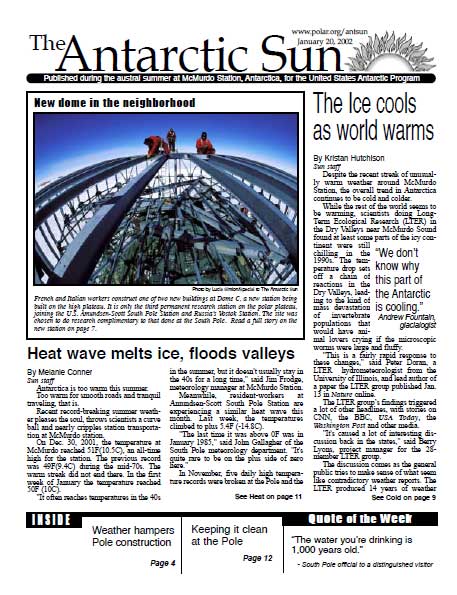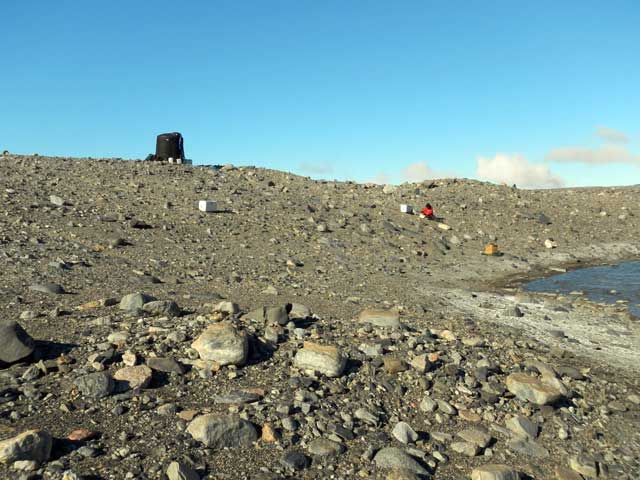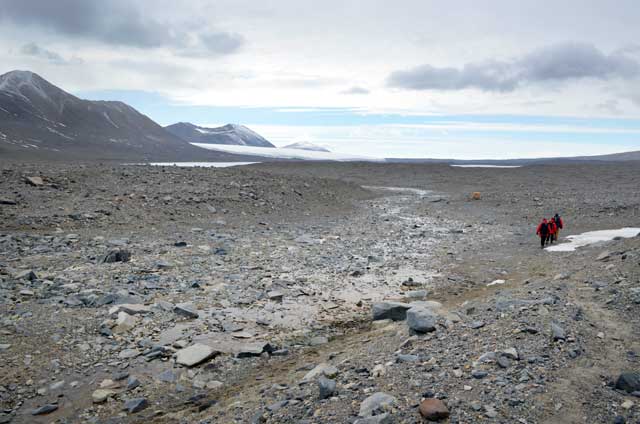|
Page 2/2 - Posted September 27, 2013
Yet Complex
The front page of the Jan. 20, 2002 issue of The Antarctic Sun newspaper, which was published from 1997 to 2007, contains dueling headlines of climate cooling and warming in the McMurdo Dry Valleys.
The future is where researchers are starting to look, even as they continue to interpret the climactic and geologic past and measure the present day state of the Dry Valleys system. For more than a decade, from the late 1980s into the early 2000s, the Dry Valleys were cooling. The LTER researchers even published a paper in the journal Nature in January 2002 showing the cooling trend, which caused a drop in stream flow and an increase in lake ice thickness. However, that same season as the publication, a major flood swept through Taylor Valley, increasing lake levels by more than a meter. The Onyx River in nearby Wright Valley flowed at 700 cubic feet per second, fast enough to whitewater raft along its 32 kilometers length. “It almost took out all of the [stream] gauges, there was so much water,” says McKnight, who heads the “stream team,” a group that monitors the flow of more than a dozen ephemeral meltwater creeks and rivers throughout the valleys. The cooling trend has since been connected to depletion of ozone, a greenhouse gas that was being destroyed by manmade chlorofluorocarbons. A treaty known as the Montreal Protocol Long-term predictions by the McMurdo LTER team suggest that the region will eventually warm, creating more floods in the future. Studies have shown that the tipping point for such pulse events of water hovers right around the freezing point. 
Photo Credit: Tyler Kohler/Antarctic Photo Library
Scientist Devin Castendyk, a member of the McMurdo LTER team conducts, a flow measurement on the Onyx River in the Wright Valley. The Onyx is the longest river in Antarctica at 32 kilometers.
“These systems are so poised on the edge that these big warm events have a big impact for what happens over the next five or six years,” McKnight says. Well ConnectedTemperature is only part of the equation. Wind also plays a role, blowing sediment onto snowpack and glaciers; the dark material more readily absorbs ultraviolet radiation, causing the ice to melt even before it heats up. In fact, the temperature during two subsequent high-flow summers was less than the great flood year. Such pulse events of water increase connectivity across the landscape between the soils, streams and lakes. “It’s not just connection of water and sediment, but also organisms and nutrients,” McKnight says. Adds Barrett: “We view [the valleys] as an integrated series of landscapes – glaciers, soils, streams and lakes. In terms of transport, the streams are the major conduit for the transfer of material and energy.” The P3 experiment – Pulse and Press Project – at Many Glaciers Pond will look deeper into those connections by simulating melt events. One plot will receive a pulse of water every three years, with water from Many Glaciers Pond pumped up to the 1,000-gallon tank at the top of the hill. A second plot will be hit with water each year, as the press event to represent a state change. A third plot will be left alone as a control site. 
Photo Credit: McMurdo LTER
The P3 experiment – Pulse and Press Project – at Many Glaciers Pond in Taylor Valley will examine what might happen to the Dry Valleys in the future if conditions grow wetter.
“The hypothesis is that if you get these large melt events, that should be a homogenizing influence on the soil environment,” explains Barrett, who is overseeing the experiment, which will be “turned on” during the 2013-14 field season. The researchers will analyze everything from changes in soil chemistry to the possible drop of diversity in bacteria and invertebrates as the water seeps down the slope. “I think the changes in the microbiology are going to be less than the changes you see in the chemistry and the changes you see in the invertebrates,” says Barrett, who started on the McMurdo LTER as a post-doc with Virginia at Dartmouth in 1999-2000 before coming aboard as a principal investigator on the current grant cycle. Wall suspects that the hardy Scottnema linsayae nematode, for example, will be forced to higher and drier latitudes if the Dry Valleys enter a new warmer and wetter state of affairs. Still, wholesale predictions about the Dry Valleys a few centuries from now are difficult. “It’s a new, novel ecosystem, and we don’t know what’s going to happen,” Wall says. |



For USAP Participants |
For The Public |
For Researchers and EducatorsContact UsU.S. National Science FoundationOffice of Polar Programs Geosciences Directorate 2415 Eisenhower Avenue, Suite W7100 Alexandria, VA 22314 Sign up for the NSF Office of Polar Programs newsletter and events. Feedback Form |


